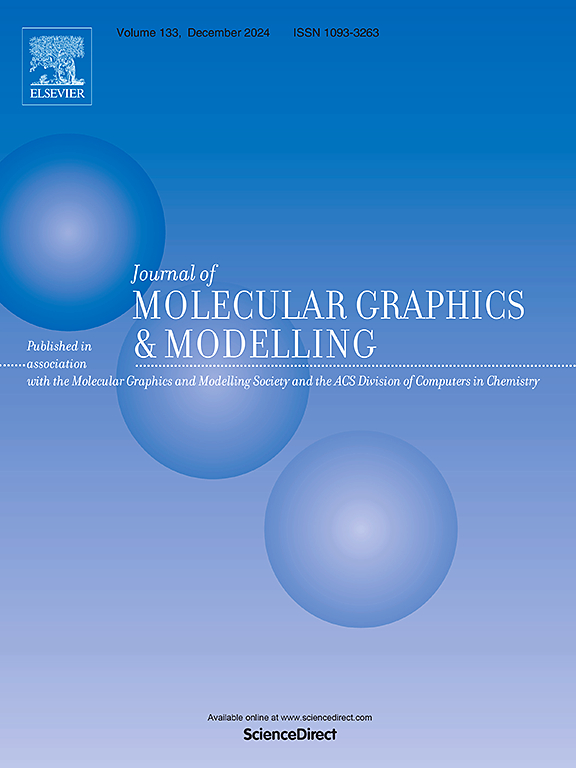Harnessing computational tools for drug discovery: An integrated computational approach to identify potential BACE-1 inhibitors
IF 3
4区 生物学
Q2 BIOCHEMICAL RESEARCH METHODS
引用次数: 0
Abstract
The hallmark of Alzheimer's disease (AD), a progressive neurodegenerative condition, is the buildup of amyloid-beta (Aβ) plaque, which is mainly caused by β-secretase 1 (BACE-1) activity. BACE-1 inhibition is a potentially effective treatment strategy to lower the progression of AD. In order to find possible BACE-1 inhibitors using a drug repurposing technique, this study uses an integrated computational approach that includes pharmacophore modelling, virtual screening, molecular docking, MM-GBSA, molecular dynamics (MD) simulations, in-silico ADMET profiling, and PBPK modelling. A pharmacophore model, was created with known BACE-1 inhibitors to enable virtual screening of both novel and FDA-approved chemical libraries. Top candidates with good free energy scores and strong binding affinities were found using molecular docking and MM-GBSA calculations. The stability of shortlisted Hits inside the BACE-1 active site was further validated using MD simulations, which showed that some of the important interactions were maintained across a period of 50ns. ADMET and PBPK studies predicted favorable pharmacokinetic and safety profiles for the shortlisted hits, particularly for B2 and B9. These findings identify potential candidates for future experimental validation, offering an inexpensive approach for identification of compounds as potential BACE-1 inhibitors.

利用计算工具进行药物发现:一种综合计算方法来识别潜在的BACE-1抑制剂
阿尔茨海默病(AD)是一种进行性神经退行性疾病,其特征是淀粉样蛋白- β (a β)斑块的积聚,这主要是由β分泌酶1 (BACE-1)活性引起的。BACE-1抑制是一种潜在的有效治疗策略,可以降低AD的进展。为了利用药物重新利用技术找到可能的BACE-1抑制剂,本研究使用了一种综合计算方法,包括药效团建模、虚拟筛选、分子对接、MM-GBSA、分子动力学(MD)模拟、硅ADMET分析和PBPK建模。使用已知的BACE-1抑制剂创建药效团模型,以实现新型和fda批准的化学文库的虚拟筛选。通过分子对接和MM-GBSA计算,找到了自由能分数高、结合亲和力强的候选分子。通过MD模拟进一步验证了候选hit在BACE-1活性位点内的稳定性,结果表明一些重要的相互作用在50ns的时间内保持不变。ADMET和PBPK研究预测候选候选药物,特别是B2和B9具有良好的药代动力学和安全性。这些发现为未来的实验验证确定了潜在的候选化合物,为鉴定潜在的BACE-1抑制剂提供了一种廉价的方法。
本文章由计算机程序翻译,如有差异,请以英文原文为准。
求助全文
约1分钟内获得全文
求助全文
来源期刊

Journal of molecular graphics & modelling
生物-计算机:跨学科应用
CiteScore
5.50
自引率
6.90%
发文量
216
审稿时长
35 days
期刊介绍:
The Journal of Molecular Graphics and Modelling is devoted to the publication of papers on the uses of computers in theoretical investigations of molecular structure, function, interaction, and design. The scope of the journal includes all aspects of molecular modeling and computational chemistry, including, for instance, the study of molecular shape and properties, molecular simulations, protein and polymer engineering, drug design, materials design, structure-activity and structure-property relationships, database mining, and compound library design.
As a primary research journal, JMGM seeks to bring new knowledge to the attention of our readers. As such, submissions to the journal need to not only report results, but must draw conclusions and explore implications of the work presented. Authors are strongly encouraged to bear this in mind when preparing manuscripts. Routine applications of standard modelling approaches, providing only very limited new scientific insight, will not meet our criteria for publication. Reproducibility of reported calculations is an important issue. Wherever possible, we urge authors to enhance their papers with Supplementary Data, for example, in QSAR studies machine-readable versions of molecular datasets or in the development of new force-field parameters versions of the topology and force field parameter files. Routine applications of existing methods that do not lead to genuinely new insight will not be considered.
 求助内容:
求助内容: 应助结果提醒方式:
应助结果提醒方式:


